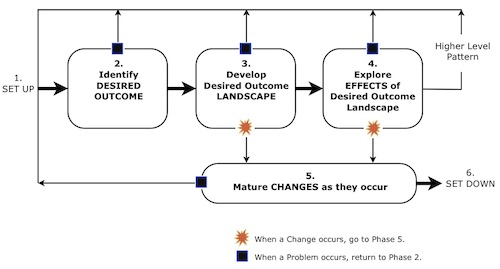Nassim Nicholas Taleb, author of The Black Swan believes that innovation, both of knowledge and technology, is mostly driven by “stochastic tinkering”. Even though it is mostly described after the fact, in top-down directed research terms [see our article ‘Black Swan Logic’].
Here ‘stochastic’ relates to randomness (effective as well as actual) and serendipity – aiming for ‘A’ and discovering ‘B’ instead. “Tinkering” means adjusting and experimenting, usually in small amounts [See our article ‘Maximising Serendipity’]. Taleb notes that Alexander of Aphrodisias maintained that for the “stochastic arts the end is not the achieving of their objective, but the completion of what belongs to the art itself”.[1]
Thus stochastic tinkering requires experimenting in small ways, noticing the new or unexpected, and using that to continue to experiment. This could be a one-line definition of the underlying methodology used in Symbolic Modelling. The general principle is: Do as little as possible unless the system shows you have to do more, then do only as much as you need to keep the process going. Similarly, with her work in organisations Caitlin Walker says she attempts to use “the lightest touch”.
In contrast, on Saturday, Penny Tompkins and I attended the annual UKCP Conference on clinical supervision. The prevailing assumption seemed to be that most, if not all, psychological symptoms are caused by childhood trauma, and that’s what has to be remedied. I believe stochastic tinkering is more ecological for the client (and the wider system of which they are a part), and in most cases more efficient than starting out with such a predetermined end-in-mind.
Penny and I have recently created a simplified version of Symbolic Modelling, which we call Symbolic Modelling Lite.[2] One of the key features of this approach is the directive: whenever a change occurs, Mature the change and find out what effect it has. You can see how this is pure stochastic tinkering. Of course it begs the question: What do you do when a change doesn’t happen? I have been dialoging with Phil Swallow about how to present the answer, and this is where I’ve got to:
Meta-Process for using Symbolic Modelling
Start by using Symbolic Modelling Lite (as shown in the diagram below)

If, having gone round the loops a few times, a change (that makes a valued difference) has not occurred, then
and/or Go Live and/or Identify Necessary Conditions
If a change (that makes a valued difference) still has not occurred, then
If a change (that makes a valued difference) still has not occurred, then
If a change (that makes a valued difference) still has not occurred, then
Whenever a change does occur, Mature the change to find out whether that makes a valued difference.
Phil went straight to the guts of the matter by questioning of whether people can use a model like this, with it’s linear representation, to do the messy, systemic business involved in modelling. We shall see.
My next blogs follow on with this theme and asks: but what if there is no change?
NOTES
1 Quote from: fooledbyrandomness.com/notebook.htm. There is an interesting blog about applying stochastic tinkering to education and business policy-making posted by CSIS, the Center for Strategic and International Studies.
2 ‘Symbolic Modelling Lite’ has been written up as a chapter in Innovations in NLP edited by Michael Hall and Shelle Rose Charvet (Crown House, 2011).








